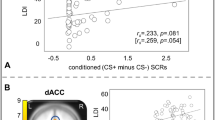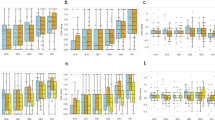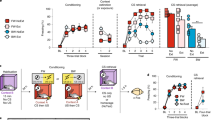Abstract
Fear conditioning is a fundamentally important and preserved process across species1,2. In humans it is linked to fear-related disorders such as phobias and post-traumatic stress disorder (PTSD)3,4. Fear memories can be reduced by counter-conditioning, in which fear conditioned stimuli (CS+s) are repeatedly reinforced with reward5 or with novel non-threatening stimuli6. However, this procedure involves explicit presentations of CS+s, which is itself aversive before fear is successfully reduced. This aversiveness may be a problem when trying to translate such experimental paradigms into clinical settings7. It also raises the fundamental question as to whether explicit presentations of feared objects is necessary for fear reduction1,8. Although learning without explicit stimulus presentation has been previously demonstrated9–12, whether fear can be reduced while avoiding explicit exposure to CS+s remains largely unknown. One recently developed approach employs an implicit method to induce learning by reinforcing stimulus-specific neural representations using real-time decoding of multivariate functional magnetic resonance imaging (fMRI) signals13–15 in the absence of stimulus presentation; that is, pairing rewards with the occurrences of multi-voxel brain activity patterns matching a specific stimulus (decoded fMRI neurofeedback (DecNef)13,15). It has been shown that participants exhibit perceptual learning for a specific visual stimulus feature through DecNef, without being given any strategy for the induction of specific neural representations, and without awareness of the content of reinforced neural representations13. Here we examined whether a similar approach could be applied to counter-conditioning of fear. We show that we can reduce fear towards CS+s by pairing rewards with the activation patterns in visual cortex representing a CS+, while participants remain unaware of the content and purpose of the procedure. This procedure may be an initial step towards novel treatments for fear-related disorders such as phobia and PTSD, via unconscious processing.
This is a preview of subscription content, access via your institution
Access options
Subscribe to this journal
Receive 12 digital issues and online access to articles
$119.00 per year
only $9.92 per issue
Buy this article
- Purchase on Springer Link
- Instant access to full article PDF
Prices may be subject to local taxes which are calculated during checkout




Similar content being viewed by others
References
LeDoux, J. Anxious (Oneworld Publications, 2015).
Schiller, D. et al. Preventing the return of fear in humans using reconsolidation update mechanisms. Nature 463, 49–53 (2010).
Lissek, S. et al. Classical fear conditioning in the anxiety disorders: a meta-analysis. Behav. Res. Ther. 43, 1391–1424 (2005).
Yehuda, R. & LeDoux, J. Response variation following trauma: a translational neuroscience approach to understanding PTSD. Neuron 56, 19–32 (2007).
Dickinson, A. & Dearing, M. in Mechanisms of Learning and Motivation (eds Dickinson, A. & Boakes, R. A. ) Ch. 8 (Psychology Press, 1979).
Dunsmoor, J. E., Campese, V. D., Ceceli, A. O., LeDoux, J. E. & Phelps, E. A. Novelty-facilitated extinction: providing a novel outcome in place of an expected threat diminishes recovery of defensive responses. Biol. Psychiatry 78, 203–209 (2015).
Schnurr, P. P. et al. Cognitive behavioral therapy for posttraumatic stress disorder in women: a randomized controlled trial. JAMA 297, 820–830 (2007).
Siegel, P. & Weinberger, J. Less is more: the effects of very brief versus clearly visible exposure. Emotion 12, 394–402 (2012).
Esteves, F., Parra, C., Dimberg, U. & Ohman, A. Nonconscious associative learning: Pavlovian conditioning of skin conductance responses to masked fear-relevant facial stimuli. Psychophysiology 31, 375–385 (1994).
Knight, D. C., Nguyen, H. T. & Bandettini, P. A. Expression of conditional fear with and without awareness. Proc. Natl Acad. Sci. USA 100, 15280–15283 (2003).
Raio, C. M., Carmel, D., Carrasco, M. & Phelps, E. A. Nonconscious fear is quickly acquired but swiftly forgotten. Curr. Biol. 22, R477–R479 (2012).
Redondo, R. L. et al. Bidirectional switch of the valence associated with a hippocampal contextual memory engram. Nature 513, 426–430 (2014).
Shibata, K., Watanabe, T., Sasaki, Y. & Kawato, M. Perceptual learning incepted by decoded fMRI neurofeedback without stimulus presentation. Science 334, 1413–1415 (2011).
deBettencourt, M. T., Cohen, J. D., Lee, R. F., Norman, K. A. & Turk-Browne, N. B. Closed-loop training of attention with real-time brain imaging. Nat. Neurosci. 18, 470–475 (2015).
Amano, K., Shibata K., Kawato, M., Sasaki, Y. & Watanabe, T. Learning to associate orientation with color in early visual areas by associative decoded fMRI neurofeedback. Curr. Biol 26, 1861–1866 (2016).
Bouton, M. E. Context and behavioral processes in extinction. Learn. Mem. 11, 485–494 (2004).
Milad, M. R. et al. Neurobiological basis of failure to recall extinction memory in posttraumatic stress disorder. Biol. Psychiatry 66, 1075–1082 (2009).
Milad, M. R. et al. Recall of fear extinction in humans activates the ventromedial prefrontal cortex and hippocampus in concert. Biol. Psychiatry 62, 446–454 (2007).
Phelps, E. A., Delgado, M. R., Nearing, K. I. & LeDoux, J. E. Extinction learning in humans: role of the amygdala and vmPFC. Neuron 43, 897–905 (2004).
Do-Monte, F. H., Manzano-Nieves, G., Quiñones-Laracuente, K., Ramos-Medina, L. & Quirk, G. J. Revisiting the role of infralimbic cortex in fear extinction with optogenetics. J. Neurosci. 35, 3607–3615 (2015).
Schiller, D., Kanen, J. W., LeDoux, J. E., Monfils, M.-H. & Phelps, E. A. Extinction during reconsolidation of threat memory diminishes prefrontal cortex involvement. Proc. Natl Acad. Sci. USA 110, 20040–20045 (2013).
Kriegeskorte, N., Goebel, R. & Bandettini, P. Information-based functional brain mapping. Proc. Natl Acad. Sci. USA 103, 3863–3868 (2006).
Haruno, M. & Kawato, M. Different neural correlates of reward expectation and reward expectation error in the putamen and caudate nucleus during stimulus-action-reward association learning. J. Neurophysiol. 95, 948–959 (2006).
O’Doherty, J. et al. Dissociable roles of ventral and dorsal striatum in instrumental conditioning. Science 304, 452–454 (2004).
Friston, K. J. et al. Psychophysiological and modulatory interactions in neuroimaging. Neuroimage 6, 218–229 (1997).
Sarrazin, J.-C., Cleeremans, A. & Haggard, P. How do we know what we are doing? Time, intention and awareness of action. Conscious. Cogn. 17, 602–615 (2008).
Koenigs, M. et al. Focal brain damage protects against post-traumatic stress disorder in combat veterans. Nat. Neurosci. 11, 232–237 (2008).
Kim, J. H., Hamlin, A. S. & Richardson, R. Fear extinction across development: the involvement of the medial prefrontal cortex as assessed by temporary inactivation and immunohistochemistry. J. Neurosci. 29, 10802–10808 (2009).
Emmert, K. et al. Meta-analysis of real-time fMRI neurofeedback studies using individual participant data: how is brain regulation mediated? Neuroimage 124, 806–812 (2016).
Brooks, D. C., Beth, H., Nelson, J. B. & Bouton, M. E. Reinstatement after counterconditioning. Anim. Learn. Behav. 23, 383–390 (1995).
LaBar, K. S. & Phelps, E. A. Reinstatement of conditioned fear in humans is context dependent and impaired in amnesia. Behav. Neurosci. 119, 677–686 (2005).
Norrholm, S. D. et al. Conditioned fear extinction and reinstatement in a human fear-potentiated startle paradigm. Learn. Mem. 13, 681–685 (2006).
Hermans, D. et al. Reinstatement of fear responses in human aversive conditioning. Behav. Res. Ther. 43, 533–551 (2005).
Haxby, J. V. et al. A common, high-dimensional model of the representational space in human ventral temporal cortex. Neuron 72, 404–416 (2011).
Engel, S. A., Glover, G. H. & Wandell, B. A. Retinotopic organization in human visual cortex and the spatial precision of functional MRI. Cereb. Cortex 7, 181–192 (1997).
Yamashita, O., Sato, M.-A., Yoshioka, T., Tong, F. & Kamitani, Y. Sparse estimation automatically selects voxels relevant for the decoding of fMRI activity patterns. Neuroimage 42, 1414–1429 (2008).
Kobayashi, S. et al. Influences of rewarding and aversive outcomes on activity in macaque lateral prefrontal cortex. Neuron 51, 861–870 (2006).
Bray, S., Shimojo, S. & O’Doherty, J. P. Direct instrumental conditioning of neural activity using functional magnetic resonance imaging-derived reward feedback. J. Neurosci. 27, 7498–7507 (2007).
Lonsdorf, T. B., Haaker, J. & Kalisch, R. Long-term expression of human contextual fear and extinction memories involves amygdala, hippocampus and ventromedial prefrontal cortex: a reinstatement study in two independent samples. Soc. Cogn. Affect. Neurosci. 9, 1973–1983 (2014).
Kalisch, R. et al. Context-dependent human extinction memory is mediated by a ventromedial prefrontal and hippocampal network. J. Neurosci. 26, 9503–9511 (2006).
Tziortzi, A. C. et al. Imaging dopamine receptors in humans with [11C]-(+)-PHNO: dissection of D3 signal and anatomy. Neuroimage 54, 264–277 (2011).
Nichols, T. E. & Holmes, A. P. Nonparametric permutation tests for functional neuroimaging: a primer with examples. Hum. Brain Mapp. 15, 1–25 (2002).
Acknowledgements
We thank K. Nakamura for her help in scheduling and conducting the experiment, N. Hiroe for assistance with equipment, Y. Shimada and A. Nishikido for operating the fMRI scanner, H. Ban for technical advice, and M. Craske, M. Treanor, M. Sun, A. Izquierdo and F. Krasne for their comments on the manuscript. The study was conducted in the ImPACT Program of Council for Science, Technology and Innovation (Cabinet Office, Government of Japan). This work was partially supported by ‘Brain Machine Interface Development’ under the Strategic Research Program for Brain Sciences supported by the Japan Agency for Medical Research and Development (AMED), the ATR entrust research contract from the National Institute of Information and Communications Technology, and the US National Institute of Neurological Disorders and Stroke of the National Institutes of Health (grant no. R01NS088628 to H.L.). B.S. is funded by the Wellcome Trust, UK. The funders had no role in study design, data collection and analysis, decision to publish, or preparation of the manuscript.
Author information
Authors and Affiliations
Contributions
A.K., H.L., B.S. and M.K. designed the study while actively discussing with other co-authors, A.K., K.A. and A.C. implemented the experiment, A.K. conducted the experiment, A.K., K.S., A.C., H.L. and M.K. analysed the results with the support of K.A. and W.Y. A.K., B.S., H.L. and M.K. wrote the manuscript.
Corresponding authors
Ethics declarations
Competing interests
K.S. and M.K. are the inventors of patents related to the DecNef method used in this study, and the original assignee of the patents is ATR, with which some of the authors are affiliated.
Supplementary information
Supplementary information
Supplementary Figures 1–7, Supplementary Methods, Supplementary Table 1, Supplementary References. (PDF 1142 kb)
Rights and permissions
About this article
Cite this article
Koizumi, A., Amano, K., Cortese, A. et al. Fear reduction without fear through reinforcement of neural activity that bypasses conscious exposure. Nat Hum Behav 1, 0006 (2017). https://doi.org/10.1038/s41562-016-0006
Received:
Accepted:
Published:
DOI: https://doi.org/10.1038/s41562-016-0006
This article is cited by
-
Mental imagery can generate and regulate acquired differential fear conditioned reactivity
Scientific Reports (2022)
-
The DecNef collection, fMRI data from closed-loop decoded neurofeedback experiments
Scientific Data (2021)
-
Multivoxel pattern analysis reveals dissociations between subjective fear and its physiological correlates
Molecular Psychiatry (2020)
-
Social-Eyes: Rich Perceptual Contents and Systemic Oppression
Review of Philosophy and Psychology (2020)
-
Process-based framework for precise neuromodulation
Nature Human Behaviour (2019)



